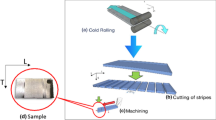Abstract
The use of an impregnated abrasive tool in grinding stainless steel (12X18H10T) is investigated. The roughness of the machined surface and the grinding ratio are considerably better than when a traditional tool is employed.
Similar content being viewed by others
References
Shal’nov, V.A., Shlifovanie i polirovanie vysokoprochnykh materialov (Grinding and Polishing of High-Strength Materials), Moscow: Mashinostroenie, 1972.
Chirkov, G.V., Influence of the grinding wheel impregnation on the processing quality, Tekhnol. Mashinostr., 2007, no. 2, pp. 22–23.
Nikitin, A.V., Grinding of refractory materials by impregnated wheels to improve their cutting properties, Instrum. Tekhnol., 2010, no. 2, pp. 52–58.
CN Patent 101791786, 2010.
US Patent 6500220, 2002.
Bhanu, P.R., Bhanu, K.G., and Rukmini, S.R., Performance evaluation of grinding wheels impregnated with graphene nanoplatelets, Int. J. Adv. Manuf. Technol., 2016, vol. 85, pp. 2235–2245.
Nadolny, K., Kaplonek, W., Wojtewicz, M., and Sienicki, W., Effects of sulfurization of grinding wheels on internal cylindrical grinding of Titanium Grade 2®, Indian J. Eng. Mater. Sci., 2013, vol. 20, pp. 108–124.
Nadolny, K., Sienicki, W., and Wojtewicz, M., The effect upon the grinding wheel active surface condition when impregnating with non-metallic elements during internal cylindrical grinding of titanium, Arch. Civil Mech. Eng., 2015, vol. 15, pp. 71–86.
Latyshev, V.N. and Naumov, A.G., The lubricating and chemical effect of the environment during cutting metals, Trenie Iznos, 2001, vol. 22, no. 3, pp. 342–348.
Tsokur, A.K. and Tsokur, V.P., The role of physicalchemical phenomena in the heat balance during grinding, Nauch. Tr. Donetsk. Nats. Tekh. Univ., Ser. Mashinostr. Mashinoved., 2007, pp. 56–61.
Nikolaev, A.F. and Okhrimenko, O.G., Vodorastvorimye polimery (Water-Soluble Polymers), Leningrad: Khimiya, 1979.
Ghosh, S., Kumar, M.K., and Kain, V., High temperature oxidation behavior of AISI 304L stainless steel— effect of surface working operations, Appl. Surf. Sci., 2013, vol. 264, pp. 312–319.
Mitrofanov, A.P., Nosenko, V.A., and Butov, G.M., New impregnators for the impregnation of abrasive tools, Fundam. Prikl. Probl. Tekhn. Tekhnol., 2011, nos. 4–3, pp. 48–54.
Nosenko, V.A., Mitrofanov, A.P., and Butov, G.M., Impregnation of abrasive tools with foaming agents, Russ. Eng. Res., 2011, vol. 31, no. 11, pp. 1160–1163.
Anur’ev, V.I., Spravochnik konstruktora-mashinostroitelya (Handbook of Machine Engineer), Zhestkova, I.N., Ed., Moscow: Mashinostroenie, 2001, vol. 1, 8th ed.
Author information
Authors and Affiliations
Corresponding author
Additional information
Original Russian Text © A.P. Mitrofanov, K.A. Parsheva, 2017, published in Vestnik Mashinostroeniya, 2017, No. 6, pp. 75–79.
About this article
Cite this article
Mitrofanov, A.P., Parsheva, K.A. More efficient grinding of hard-to-cut materials. Russ. Engin. Res. 37, 789–792 (2017). https://doi.org/10.3103/S1068798X17090180
Published:
Issue Date:
DOI: https://doi.org/10.3103/S1068798X17090180




